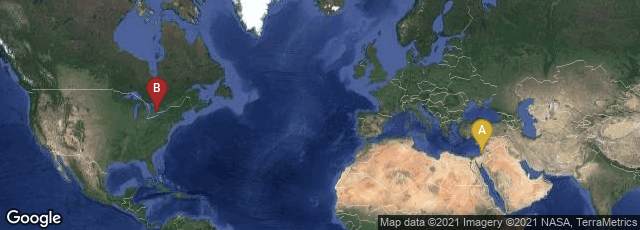
A: Tel Aviv-Yafo, Tel Aviv District, Israel, B: Old Toronto, Toronto, Ontario, Canada
For years I have followed computer applications in the humanities. Some, such as HistoryofInformation.com, are on a small personal scale. Others involve enormous corpora of data, as in computational linguistics, where larger seems always to be better.
The project called "Re-joining the Cairo Genizah", a joint venture of Genazim, The Friedberg Genizah Project, founded in 1999 in Toronto, Canada, and The Blavatnik School of Computer Science at Tel-Aviv University, seems potentially to be one of the most productive large scale projects currently underway. Because about 320,000 pages and parts of pages from the Genizah — in Hebrew, Aramaic, and Judeo-Arabic (Arabic transliterated into Hebrew letters) — are scattered in 67 libraries and private collections around the world, only a fraction of them have been collated and cataloged. Though approximately 200 books were published on the Genizah manuscripts by 2013, perhaps only 4,000 of the manuscripts were pieced together through a painstaking, expensive, exclusive process that relied a lot on luck.
In 2013 the Genazim project was underway to collate and piece together as many of these fragments as could be re-assembled using current computing technology:
"First there was a computerized inventory of 301,000 fragments, some as small as an inch. Next came 450,000 high-quality photographs, on blue backgrounds to highlight visual cues, and a Web site where researchers can browse, compare, and consult thousands of bibliographic citations of published material.
"The latest experiment involves more than 100 linked computers located in a basement room at Tel Aviv University here, cooled by standup fans. They are analyzing 500 visual cues for each of 157,514 fragments, to check a total of 12,405,251,341 possible pairings. The process began May 16 and should be done around June 25, according to an estimate on the project’s Web site.
"Yaacov Choueka, a retired professor of computer science who runs the Friedberg-financed Genazim project in Jerusalem, said the goals are not only to democratize access to the documents and speed up the elusive challenge of joining fragments, but to harness the computer’s ability to pose new research questions. . . .
"Another developing technology is a 'jigsaw puzzle' feature, with touch-screen technology that lets users enlarge, turn and skew fragments to see if they fit together. Professor Choueka, who was born in Cairo in 1936, imagines that someday soon such screens will be available alongside every genizah collection. And why not a genizah-jigsaw app for smartphones?
“ 'The thing it really makes possible is people from all walks of life, in academia and out, to look at unpublished material,' said Ben Outhwaite, head of the Genizah Research Unit at Cambridge University, home to 60 percent of the fragments. 'No longer are we going to see a few great scholarly names hoarding particular parts of the genizah and have to wait 20 years for their definitive publication. Now everyone can dive in.'
"What they will find goes far beyond Judaica. . . . Marina Rustow, a historian at Johns Hopkins University, said about 15,000 genizah fragments deal with everyday, nonreligious matters, most of them dated 950 to 1250. From these, she said, scholars learned that Cairenes imported sheep cheese from Sicily — it was deemed kosher — and filled containers at the bazaar with warm food in an early version of takeout" (http://www.nytimes.com/2013/05/27/world/middleeast/computers-piecing-together-jigsaw-of-jewish-lore.html?pagewanted=2&hp, accessed 05-27-2013)